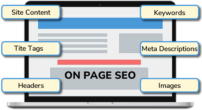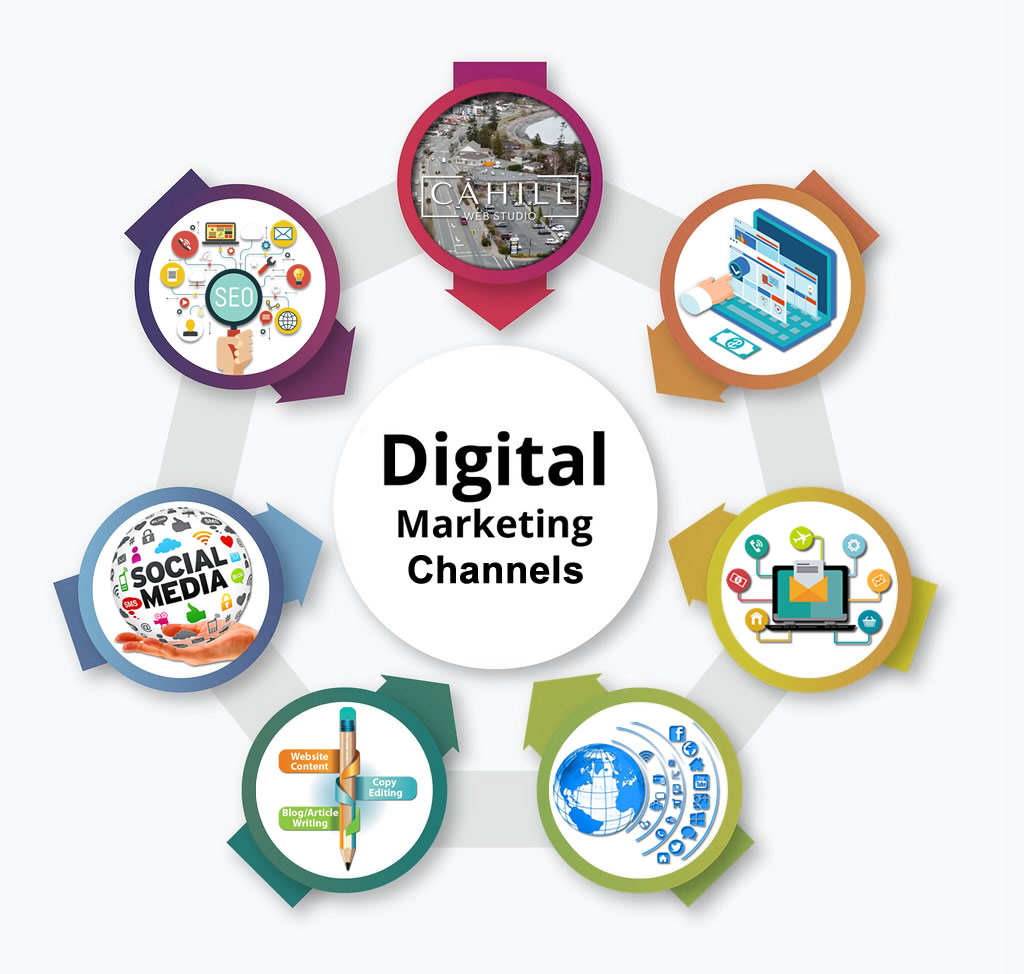
Digital Marketing Strategy
A Game-Changer for Small Business
This guide aims to be your ultimate resource for crafting a digital marketing strategy that propels your small business into the digital age.
The Digital Imperative
In today’s rapidly evolving digital landscape, having a robust digital marketing strategy is no longer a “nice-to-have”—it’s a non-negotiable.
For small businesses, this isn’t just about keeping up with the Joneses. It’s about seizing a golden opportunity to level the playing field and go toe-to-toe with larger corporations.
The Power of Precision
One of the most compelling advantages of digital marketing is its ability to target audiences with surgical precision. Gone are the days of casting a wide net and hoping for the best. With advanced tools and analytics, you can now reach your ideal customer at the right time, in the right place, and with the right message. This isn’t just marketing;this is marketing smart.
Budget-Friendly Marketing
beauty of digital marketing lies in its cost-effectiveness. Unlike traditional marketing avenues that can eat up your budget faster than you can say “print ad,” digital marketing offers scalable solutions that provide a high return on a modest investment.
Building a Brand That Resonates
A strong online presence does more than just make your brand visible—it makes it memorable. Consistent messaging, compelling content, and
meaningful engagement can turn casual browsers into loyal customers. In a crowded marketplace, a well-crafted digital marketing strategy can
elevate your brand from “just another option” to “the only choice.”
The Bottom Line: Sales and ROI
At the end of the day, it all boils down to numbers. A well-executed digital marketing strategy doesn’t just drive traffic—it drives qualified leads, conversions, and, most importantly, sales. With the right approach, the ROI can be nothing short of spectacular. By the Numbers
By the Numbers
80% of consumers do online research before making a purchase, highlighting the importance of a strong online presence.
45% of small businesses are tapping into the power of PPC advertising to reach their target audience.
60% of marketers cite inbound methods like SEO and content marketing as their highest quality source of leads, proving that these strategies are more than just buzzwords—they’re business drivers.
Understand Your Audience
A digital marketing strategy starts with understanding your audience. Knowing who you’re targeting is the first step in any successful digital marketing strategy.
 The Cornerstone of Success
The Cornerstone of Success
Understanding your audience isn’t just the first step in crafting a successful digital marketing strategy; it’s the cornerstone. This goes beyond mere demographics. It’s about diving deep into the psyche of your target market to understand their needs, preferences, and pain points. The more you know, the more precisely you can tailor your messaging and campaigns, leading to higher engagement and, ultimately, conversions.
The Power of Personas
Creating detailed customer personas isn’t a task to be taken lightly. This involves a deep dive into not just who your customers are, but how they think and behave. Demographics tell you ‘who,’ psychographics tell you ‘why.’ Combine these with buying behaviors, and you’ve got a 360-degree view of your target audience.
 Mapping the Customer Journey
Mapping the Customer Journey
Understanding the customer journey is like having a roadmap to success. It helps you identify key touch points where you can engage your audience and make the most impact. Whether it’s the awareness stage, consideration stage, or the decision stage, knowing when and how to reach out can make all the difference.
Identifying Pain Points
What keeps your audience up at night? What challenges are they facing that your product or service can solve?
Identifying these pain points isn’t just good business; it’s empathetic marketing. And empathy builds trust, which is the foundation of any strong brand.
Preferences Matter
In the digital age, consumer attention is a precious commodity. Knowing where your audience spends their time online and what type of content they consume can help you cut through the noise and deliver messages that resonate.
 Actionable Insights
Actionable Insights
Surveys and Feedback: Don’t underestimate the power of asking. Simple surveys and feedback forms can provide invaluable insights into what your audience wants and expects from you.
Analytics: Data doesn’t lie. Utilize analytics tools to track user behavior, preferences, and engagement. This will not only validate your assumptions but also provide new avenues for targeting.
Competitor Analysis: Keep your friends close and your competitors closer. Analyzing what your competitors are doing can provide insights into market trends and reveal gaps that you can fill.
 By the Numbers
By the Numbers
70% of companies that deliver best-in-class customer experience use customer feedback.
63% of marketers say generating traffic and leads is their top challenge.
50% of brands use customer personas to guide their marketing strategies.
Set Clear Objectives
Setting objectives is crucial for the success of your digital marketing strategy. Use SMART goals to outline your digital marketing strategy objectives.
 The GPS of Digital Marketing
The GPS of Digital Marketing
Imagine embarking on a road trip without a GPS or even a map. You might enjoy the scenery, but will you reach your destination? Setting clear and achievable objectives for your digital marketing strategy serves as your navigational tool. It provides direction, helps you allocate resources efficiently, and ensures that every action you take serves a purpose.
SMART Goals: Your Roadmap to Success
The SMART framework isn’t just an acronym; it’s a blueprint for success. Specific, Measurable, Achievable, Relevant, and Time-bound goals serve as the pillars of an effective digital marketing strategy. They provide clarity, focus, and motivation, ensuring that your team knows exactly what needs to be achieved and how to go about it.
KPIs: The Metrics That Matter
Key Performance Indicators (KPIs) are your yardstick for success. Whether it’s website traffic, conversion rates, or customer engagement, identifying the right KPIs gives you the ability to measure the effectiveness of your strategy objectively.
Budget and Resources: Fuel for the Journey
A car can’t run without fuel, and a digital marketing strategy can’t succeed without adequate resources. Determining your budget upfront allows you to allocate funds effectively, ensuring that you have the means to reach your objectives without breaking the bank.
Alignment: The Bigger Picture
Your digital marketing objectives shouldn’t exist in a vacuum. They need to align with your overall business goals, whether it’s increasing revenue, expanding your customer base, or entering new markets. This ensures cohesion and synergy across all organizational efforts.
 Actionable Insights
Actionable Insights
Goal-Setting Workshop: One of the most effective ways to set objectives is to get everyone on the same page. Conduct a goal-setting workshop with your team to brainstorm, align, and commit to your digital marketing objectives.
Benchmarking: Don’t reinvent the wheel. Use industry benchmarks to set realistic and achievable goals. This provides context and helps you understand where you stand in the grand scheme of things.
Review and Adjust: A strategy is a living document. Periodically review your objectives and make necessary adjustments based on performance metrics and analytics. This ensures that you’re always moving in the right direction.
 By the Numbers
By the Numbers
92% of marketers believe that data-driven marketing is fundamental to success, emphasizing the importance of setting measurable objectives.
76% of businesses report increased customer engagement through data-driven marketing, highlighting the impact of well-defined goals.
60% of marketers are using KPIs to measure content performance, making it a standard practice in the industry.
Choose the Right Channels
Your digital marketing strategy isn’t complete without selecting the right channels for dissemination. Whether it’s SEO or social media, each channel plays a role in your overall digital marketing strategy.
Not all digital marketing channels are created equal, especially when it comes to small businesses. The key is to identify which channels are most effective for reaching your target audience and achieving your objectives. Spreading yourself too thin can dilute your efforts and yield poor results.
The Channel Conundrum
In the digital marketing world, not all channels are created equal—especially for small businesses. The plethora of options can be both a blessing and a curse. While it’s tempting to be everywhere, spreading yourself too thin can dilute your efforts and yield poor results. The key is to be selective and strategic.
Channel Selection: The Usual Suspects
From SEO and PPC to Social Media, Email Marketing, and Content Marketing, each channel offers unique advantages. But remember, what works for one business may not work for another. The trick is to understand the nuances of each channel and how it aligns with your objectives.
 Audience Match: The Perfect Fit
Audience Match: The Perfect Fit
It’s not just about choosing the right channels; it’s about choosing the right channels for your audience. Where do they hang out online? What kind of content do they consume? Aligning your channel selection with your audience’s online behavior is crucial for effective reach and engagement.
 ROI Potential: The Bottom Line
ROI Potential: The Bottom Line
Every channel comes with its own set of costs and potential returns. Evaluate the ROI of each channel not just in terms of money, but also time, effort, and resources. This will help you make informed decisions and allocate your budget more effectively.
Multi-Channel Approach: The Balanced Act
While focusing on a single channel can yield deep engagement, a multi-channel approach can offer broader reach. However, this should only be considered if it aligns with your objectives and you have the resources to manage multiple channels effectively.
 Actionable Insights
Actionable Insights
A/B Testing: Don’t put all your eggs in one basket. Run small campaigns on different channels to gauge effectiveness. This will help you identify which channel yields the best results.
Channel Audit: Make it a habit to periodically review the performance of each channel. Use analytics to measure success and adjust your strategy accordingly.
Expert Consultation: If you’re unsure about channel selection or strategy, don’t hesitate to consult experts or agencies. A little guidance can go a long way.
 By the Numbers
By the Numbers
89% of marketers consider email as their primary channel for lead generation, making it a tried-and-true method for most businesses.
74% of businesses are actively investing in social media marketing, highlighting its importance in modern digital strategies.
65% of companies find SEO and organic presence to be the most effective channel, emphasizing the importance of a strong search engine presence.
Create High-Quality Content
Content is the cornerstone of any digital marketing strategy. From blog posts to videos, the content you create should align with your digital marketing strategy.

The Royal Rule: Content is King
You’ve probably heard it a thousand times—content is king. But let’s add a caveat: quality reigns supreme. High-quality content doesn’t just capture attention; it commands respect. It establishes your brand as an authority in your industry and serves as the fuel that powers your entire digital marketing engine.
The Content Spectrum: More Than Just Words
When we talk about content, it’s easy to think only in terms of blogs or articles. But the content landscape is vast, encompassing videos, info-graphics, podcasts, and webinars. Each format offers unique advantages and caters to different audience preferences. The key is to diversify without diluting quality.
Value Proposition: The Heart of Content
Your content should be more than just eye-catching—it should be eye-opening. It should offer real value, solving problems, answering questions, and fulfilling needs. This is what turns casual browsers into loyal followers and, eventually, customers.
SEO-Friendly: Visibility Matters
What’s the point of creating stellar content if no one sees it? Making your content SEO-friendly ensures that it doesn’t just exist; it gets found. This involves keyword optimization, meta descriptions, and high-quality backlinks, among other things.
Consistency: The Key to Engagement
Consistency isn’t just about posting regularly; it’s about posting quality content regularly. A consistent posting schedule keeps your audience engaged and coming back for more, creating a virtuous cycle of trust and engagement.
 Actionable Insights
Actionable Insights
Content Calendar: Don’t leave your content strategy to chance. Create a content calendar to plan, schedule, and track your content. This ensures that you’re always ahead of the game.
Quality Over Quantity: In the race to churn out content, quality often takes a backseat. Focus on creating fewer pieces but make them impactful, valuable, and shareable.
Repurpose Content: One good piece of content can wear many hats. Turn a blog post into a podcast, an infographic, or even a video to maximize its reach and lifespan.
 By the Numbers
By the Numbers
70% of marketers are actively investing in content marketing, making it a cornerstone of modern digital strategies.
60% of consumers admit that content like blog posts and articles influence their purchasing decisions, proving the power of well-crafted content.
88% of businesses consider video a crucial part of their marketing strategy, emphasizing the growing importance of diverse content formats.
Implement SEO Strategies
SEO is an integral part of any digital marketing strategy. From on-page to off-page SEO, every tactic should be aligned with your broader digital marketing strategy.
The Unsung Hero: SEO
Search Engine Optimization (SEO) might not be the flashiest aspect of digital marketing, but it’s arguably one of the most important. It’s the behind-the-scenes work that makes your content discoverable and puts you in front of potential customers who are actively searching for what you offer. In short, effective SEO is your ticket to increased online visibility and organic traffic.
Key Points:
On-Page SEO: The Nitty-Gritty

On-page SEO is all about optimizing the individual pages on your website. This includes everything from meta descriptions and headings to the actual
content itself. It’s the low-hanging fruit of SEO—easy to implement but incredibly impactful.
Off-Page SEO: Beyond Your Website

Off-page SEO is about building your website’s authority through high-quality backlinks and social sharing. It’s the equivalent of word-of-mouth in the digital world. The more reputable sites that link to you, the higher your authority, and the better your search engine rankings.
Local SEO: The Local Hero

For small businesses, local SEO can be a game-changer. Optimizing for local keywords and maintaining an updated Google My Business profile can put you on the map—literally. It’s about being found when local customers are looking for services or products you offer.
Technical SEO: The Backbone

Your website should be more than just pretty—it should be functional. Technical SEO ensures that your site is mobile-friendly, fast, and secure.
These factors not only improve user experience but also contribute to higher search engine rankings.
 Actionable Insights
Actionable Insights
Keyword Research: Don’t shoot in the dark. Use tools like Google Keyword Planner or SEMrush to find keywords that are relevant to your business and have high search volume.
Content Optimization: Keywords should flow naturally in your content. Include them in your headings, meta descriptions, and throughout the content where relevant.
Regular Audits: An SEO strategy is never set in stone. Conduct regular audits to identify areas for improvement and keep up with algorithm changes.
 By the Numbers
By the Numbers
68% of online experiences begin with a search engine, highlighting the importance of SEO in the user journey.
53% of all website traffic comes from organic search, making SEO a critical component of your digital marketing strategy.
46% of all Google searches are seeking local information, underlining the significance of local SEO for small businesses.
Monitor and Analyze
The final step in any successful digital marketing strategy is monitoring and analysis. Use KPIs to measure the success of your digital marketing strategy.
 The Measuring Stick: Why Analytics Matter
The Measuring Stick: Why Analytics Matter
The saying goes, “You can’t manage what you can’t measure.” This couldn’t be truer in the realm of digital marketing. Monitoring and analyzing your efforts are not just good practices—they’re necessities. They provide the insights you need to understand what’s hitting the mark and what’s missing it.
KPI Tracking: Your Performance Pulse
Key Performance
Indicators (KPIs) like traffic, engagement, conversion rates, and ROI
are the vital signs of your digital marketing health. Keeping an eye on
these metrics helps you gauge the effectiveness of your strategies and
campaigns.
Analytics Tools: Your Data Dashboard
Platforms like Google Analytics and Facebook Insights offer a treasure trove of data. These specialized tools provide comprehensive insights into user behavior, campaign performance, and much more, enabling you to make data-driven decisions.
Performance Review: The Report Card
Regular performance reviews aren’t just for employees; they’re for your digital marketing strategies too. These reviews help you identify trends, spot weaknesses, and understand the ROI of your efforts, guiding your future strategies.
Adapt and Evolve: The Only Constant is Change
The digital landscape is ever-changing. Being rigid in your strategies can be your downfall. Be prepared to adapt and evolve based on analytics, market conditions, and emerging trends.
 Actionable Insights
Actionable Insights
Set Up Alerts: Don’t wait for a quarterly review to know how you’re doing. Use analytics tools to set up real-time alerts for significant changes in metrics.
A/B Testing: The best way to improve is to experiment. Continuously run A/B tests to optimize different aspects of your campaigns.
Team Reviews: Make analytics a team sport. Hold regular meetings to discuss performance metrics and strategize for the future.
 By the Numbers
By the Numbers
64% of marketers are actively investing time in SEO, emphasizing its importance in a comprehensive digital marketing strategy.
52% of companies and agencies rely on Google Analytics as their go-to analytics software, showcasing its widespread adoption.
40% of marketers find proving the ROI of their marketing activities to be one of their biggest challenges, highlighting the importance of effective monitoring and analysis.
Your Roadmap to Digital Marketing Success
The Journey Ahead: Navigating the Digital Landscape
Digital marketing is not a static field; it’s a dynamic and ever-evolving landscape that requires constant attention and adaptation. But don’t let that intimidate you. With a well-planned strategy, the right tools, and a commitment to continuous improvement, you’re well on your way to not just navigating this landscape but mastering it.
The Recap: Your Digital Marketing Playbook
Let’s quickly revisit what we’ve covered:

Understanding Your Audience:
The cornerstone of any successful strategy.

Setting Clear
Objectives:
Your roadmap for success.
Choosing the Right Channels:
Where your audience lives.
Creating High-Quality Content:
The fuel for your digital engine.
Implementing SEO Strategies:
The unsung hero of visibility.
Monitoring and
Analyzing:
The measuring stick for success.
Each of these components plays a crucial role in building a digital marketing strategy that not only meets but exceeds your business objectives.
Next Steps: Don’t Stop Here
The end of this
guide shouldn’t be the end of your journey. Whether you’re a business
owner looking to revamp your digital marketing strategy or a marketer
seeking to up your game, the next step is action. Consider reaching out
for a consultation, downloading additional resources, or simply taking
the plunge and implementing what you’ve learned.
Don’t let this guide be another tab in your browser. Act now, not later. take the step. Your future self will thank you.
Inspired to take your digital marketing to the next level? Contact us for a free consultation. Contact Us

Glossary:
Digital Marketing Strategy: A plan that outlines how a business will achieve its marketing goals via online channels like search and social media.
SEO (Search Engine Optimization): The practice of optimizing your website to rank higher in search engine results.
PPC (Pay-Per-Click): An advertising model where you pay each time someone clicks on your ad.
KPI (Key Performance Indicator): A measurable value that demonstrates how effectively a company is achieving key business objectives.
ROI (Return on Investment): A measure used to evaluate the efficiency or profitability of an investment.
SMART Goals: Specific, Measurable, Achievable, Relevant, Time-bound objectives.
Customer Persona: A semi-fictional representation of your ideal customer based on market research and real data.
Customer Journey: The complete sum of experiences that customers go through when interacting with your brand.
Multi-Channel Approach: Using multiple channels like email, social media, and PPC to reach your audience.
A/B Testing: A method of comparing two versions of a webpage or app against each other to determine which one performs better.




 Audience Match: The Perfect Fit
Audience Match: The Perfect Fit ROI Potential: The Bottom Line
ROI Potential: The Bottom Line
 The Measuring Stick: Why Analytics Matter
The Measuring Stick: Why Analytics Matter